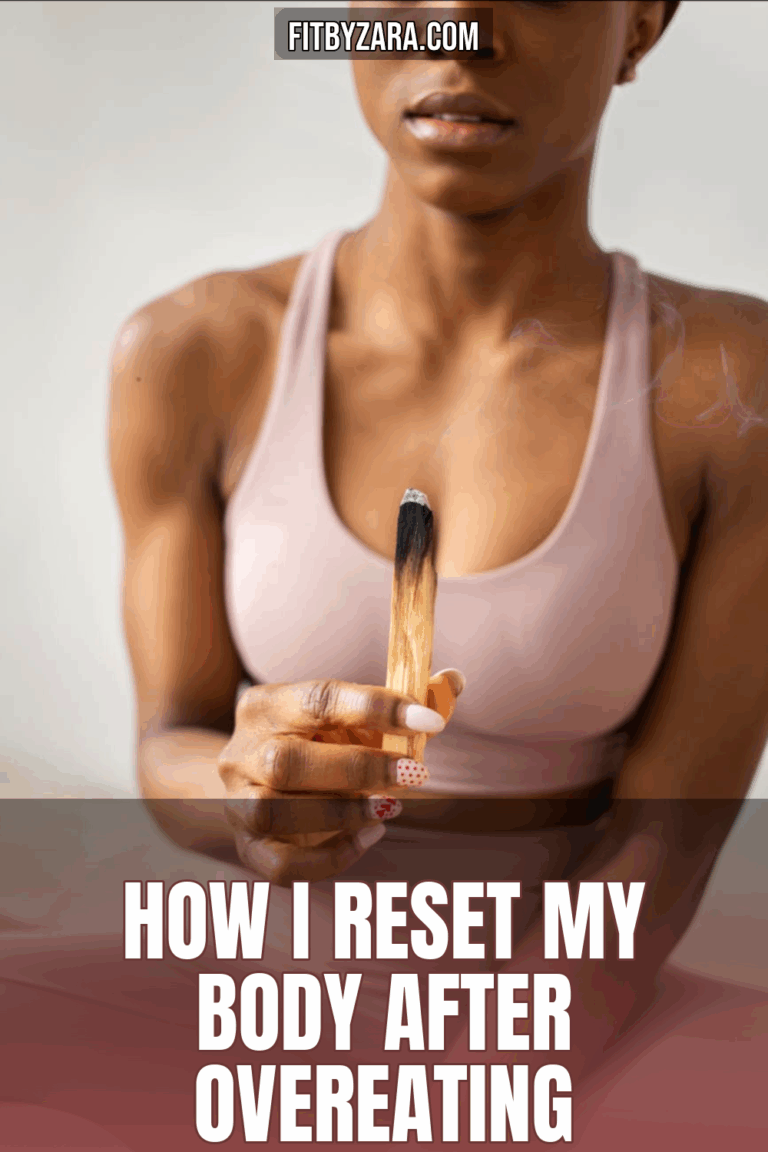Hey there, beautiful souls! If you’re reading this, chances are you’ve had one of those moments where you indulged a little too much—whether it’s a holiday feast, a birthday celebration, or just a day when the snacks were calling your name. It happens to the best of us, especially as we navigate life’s many flavors. So today, I’m sharing my tried-and-true routine for resetting my body after those moments of indulgence.

Hi, I’m Zara — fitness junkie, wellness nerd, and the voice behind FitByZara.com. This site is all about smart fitness and science-backed wellness tips for real women who want to feel their best.
Let’s dive right in!
Understanding Overeating
3-Day Energy & Metabolism Reset
Grab the 3-Day Energy & Metabolism Reset — a quick-start guide to feel lighter, more energized, and back in control.

Where should I send your free reset guide?
Overeating isn’t just about the quantity of food; it’s also about how we feel afterward. Often, it’s tied to emotional states, social situations, or just plain old cravings. It can leave us feeling bloated, lethargic, and sometimes even guilty.
But here’s the thing: Every body is different, and how we respond to food is a personal journey. The key is not to dwell on the past, but to take actionable steps towards feeling your best again.
My Reset Routine
Here’s my simple yet effective routine to reset my body after a few days (or even just a day) of overeating.
H2: Step 1: Hydrate, Hydrate, Hydrate
Why? Often, we confuse hunger with thirst. Plus, hydration helps flush out excess sodium and reduces bloating.
- Drink Water: Start your day with a glass of water. Aim for at least 8 cups throughout the day.
- Infused Water: Try adding fresh fruits (like lemon or berries) or herbs (like mint) for flavor.
- Herbal Teas: Consider sipping on ginger or peppermint tea, which can help soothe your stomach.
Mini Checklist for Hydration
- [ ] Drink a glass of water upon waking
- [ ] Carry a reusable water bottle
- [ ] Set reminders to drink water throughout the day
H2: Step 2: Move Your Body
Why? Movement is vital for digestion and helps release endorphins, which can improve your mood.
- Gentle Yoga: Start your day with a 20-minute flow to stretch and awaken your body.
- Walk It Out: A brisk 30-minute walk can work wonders. It’s low-impact and easy on your system.
- Dance Party: Put on your favorite tunes and let loose! Movement doesn’t have to be structured.
Mini Checklist for Movement
- [ ] Try a new yoga video
- [ ] Plan a daily walk
- [ ] Create a playlist for your dance party
H2: Step 3: Nourish Wisely
Why? Choosing nutrient-dense foods helps your body recover and rebalances your system.
- Whole Foods: Focus on fruits, vegetables, whole grains, and lean proteins.
- Avoid Processed Foods: They can cause bloating and discomfort.
- Fiber-Rich Foods: Include foods like quinoa, lentils, and leafy greens to aid digestion.
Suggested Eating Plan
- Breakfast: Green smoothie with spinach, banana, and almond milk.
- Lunch: Quinoa salad with chickpeas, cucumbers, and a lemon vinaigrette.
- Dinner: Grilled salmon with steamed broccoli and sweet potatoes.
- Snacks: Fresh fruit, nuts, or yogurt.
H2: Step 4: Prioritize Sleep
Why? Sleep is essential for recovery and helps regulate appetite hormones.
- Set a Sleep Schedule: Aim for 7-9 hours of quality sleep per night.
- Create a Relaxing Routine: Wind down with a book or gentle stretches before bed.
- Limit Screen Time: Try to avoid screens at least an hour before sleep.
Mini Checklist for Better Sleep
- [ ] Create a calming bedtime ritual
- [ ] Stick to a sleep schedule
- [ ] Evaluate your sleep environment—dark, cool, and quiet
H2: Step 5: Mindfulness and Reflection
Why? Taking a moment to reflect can help you understand your triggers and prevent future overeating.
- Journaling: Write down how you feel, what led to the overeating, and what you can learn from it.
- Meditation: Spend 5-10 minutes in silence, focusing on your breath to clear your mind.
- Gratitude Practice: List three things you’re grateful for each day to shift your perspective.
Mini Checklist for Mindfulness
- [ ] Journal about your feelings
- [ ] Practice 5 minutes of meditation
- [ ] Start a gratitude list
H2: Step 6: Reassess and Move Forward
Why? It’s essential to recognize that every experience is a learning opportunity.
- Set Goals: Consider what you want to achieve in the coming weeks regarding your eating habits.
- Be Kind to Yourself: Remember that one day of overeating doesn’t define you or your journey.
- Seek Support: If you find yourself struggling, talk to a friend or consider joining a community for accountability.
Mini Checklist for Moving Forward
- [ ] Set a short-term goal for balanced eating
- [ ] Identify a supportive friend or group
- [ ] Reflect on your journey weekly
*”Your body is your home. Treat it with love and respect, and it will always respond.”*
Final Thoughts
Resetting after overeating is all about kindness to yourself. It’s a process, and it’s okay to take it one step at a time. By hydrating, moving, nourishing your body, prioritizing sleep, and reflecting, you can bounce back feeling stronger and more connected to your wellness journey.
Remember, it’s not about perfection; it’s about progress. So, take a deep breath, embrace where you are, and step confidently into the next chapter of your health journey.
Stay well, lovely ladies—until next time!
HepatoBurn: Gentle Support for Steadier Days
When you’re stacking real habits—protein-forward meals, steps, and 7–9 hours of sleep—HepatoBurn is a simple add-on that supports the system behind energy, appetite, and metabolic rhythm.
Why Women 30+ Use It
- Pairs with an already-solid routine—no jitters, no crash.
- Easy to remember: 2 capsules with meals.
- Plays well with protein, walking, and strength training.
How to Use
- Timing: Breakfast & lunch are easy wins.
- Consistency: Use daily for a fair assessment.
- Stacks: Protein-first plates, post-meal walks, lights-down wind-down.
What It Isn’t
- Not a stimulant and not a magic fix.
- Best used alongside habits you’ll actually keep.
- Educational only—talk to your provider before new supplements.
Important: Educational only, not medical advice. Supplements don’t diagnose, treat, cure, or prevent diseases. Talk to your provider before changes to diet, exercise, or supplements.






















